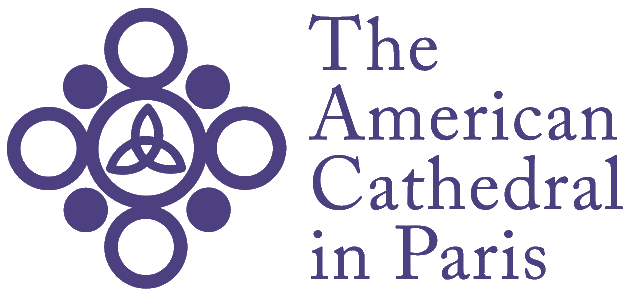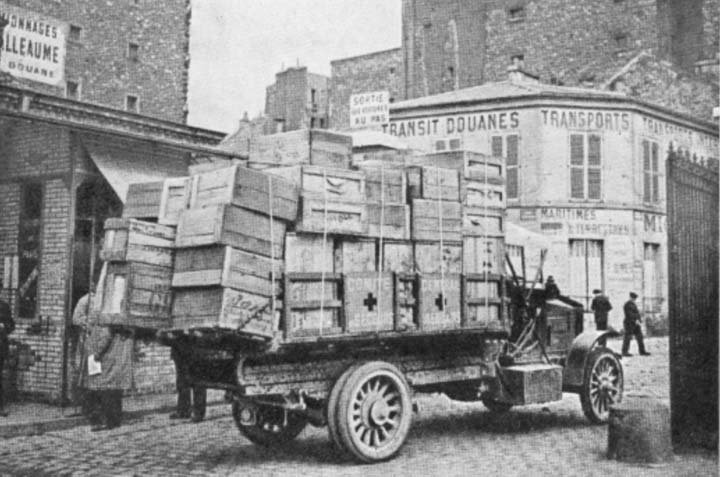The Gilded Age Goes to War 1900-1914
With thousands of Americans living in Paris at the turn of the 20th century, from wealthy bankers to struggling art students, American institutions were springing up across the city. After Holy Trinity and the American Chapel on rue de Berri, the American Chamber of Commerce set up shop in 1894 and the American Hospital opened in 1909. The American Colony, as it was referred to at the time, was growing rapidly.
Après l'office à l'église de la Sainte Trinité, Noël 1890 (Jean Béraud, 1901)
Holy Trinity parishioners of the time can be seen in Jean Béraud’s painting Après l’office (1901); gentlemen in top hats and ladies in furs and silk, waiting for their carriages to be brought around. Cameron Allen, author of The History of the American Pro-Cathedral (2013), noted that the congregation “achieved an international reputation for social exclusiveness. Members of some of the most monied of American families were found here […].”
At the same time, parishioners worked to aid destitute women through the Dorcas Society, organized at the church in 1884, and its busy Mission Work group. In 1892, Elizabeth Mills Reid, wife of the U.S. Ambassador to France Whitelaw Reid, worked with Holy Trinity’s Rev. John Brainerd Morgan to build and equip St. Luke’s Chapel for students. The chapel was on the grounds of a former porcelain factory that Mrs. Reid had purchased and established as a hostel for women students, the forerunner of today’s Reid Hall, long a center of international student programs and today home of the Columbia University Global Affairs Center.
ARCH loaded truck
Rev. Morgan died in 1912, and was succeeded in early 1913 by Rev. Samuel N. Watson, who sailed to France with U.S. Ambassador Myron T. Herrick on the Lusitania. In short order he held funeral services for banking partners J.P. Morgan and John H. Harjes, and traveled to Spain to perform the wedding ceremony for Kermit Roosevelt and his bride. Harjes had served on the Holy Trinity vestry and his son, Henry H. Harjes, was treasurer for many years.
The combination in the congregation of deep resources, social authority, and entrepreneurial spirit resulted in extraordinarily effective support for France with the onset of the Great War in 1914. Rev. Watson teamed up with Myron T. Herrick, having just stepped down from his post as ambassador, to form the American Relief Clearing House (ARCH). While the United States stayed out of the war until 1917, many Americans wanted to help. Using a borrowed warehouse and their own vehicles, ARCH handled the reception and distribution of funds and donations from 6,000 organizations. At the end of the war, its leaders calculated that they had channeled cash and goods worth $10 million. Half of the ARCH directors were vestrymen or active members of Holy Trinity.
Sewing girls at work in the American Episcopal Church, making garments for the American Ambulance Hospital. Photo: H. C. Ellis
When the United States entered the war, the American Red Cross took over the aid distribution. Henry Harjes had joined with Richard Norton to form a volunteer ambulance company, and then enlisted in the U.S. Army.
On February 8th, 1917, in decorating Rev. Watson with the cross of the Legion of Honor, French statesman Gabriel Hanotaux gratefully acknowledged the exceptional services that Dr. Watson had rendered to the French nation by his "generous activity, tireless labour, conscientiousness and tact."
Holy Trinity also became the spiritual touchstone for American families who lost loved ones in the war. Several volunteer pilots in the famed Lafayette Escadrille were interred after ceremonies at Holy Trinity, and it was some comfort to their families to be able to hold an American service for them. U.S. President Woodrow Wilson came to Paris to attend the 1919-1920 Paris Peace Conference, and attended services at Holy Trinity on December 15th, 1918.
Rev. Watson and his wife Jeanne returned to the United States after the war, and the vestry called Rev. Frederick Beekman, who had served as an army chaplain in the American Expeditionary Forces, to be the next rector. Beekman had been Dean of Nativity Chapel in Bethlehem, Pennsylvania, before the war.



